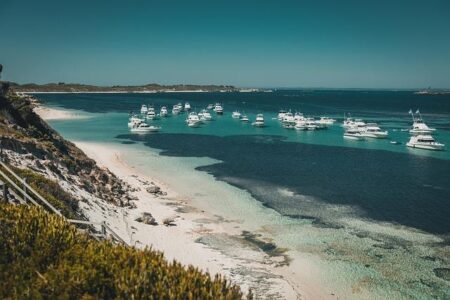South Australia is confronting an unprecedented environmental challenge as a rapidly expanding algal bloom threatens coastal ecosystems, fisheries, and local communities. Authorities and scientists alike are urgently mobilizing resources and expertise to contain the pulsating bloom, which has intensified in recent weeks along the state’s shoreline. With impacts mounting and no single solution in sight, officials are calling on every available agency, expert, and community group to join the effort to mitigate the ecological and economic fallout. This developing crisis underscores the complex intersections of climate, marine health, and regional livelihoods in South Australia.
South Australia Mobilizes Experts and Volunteers to Tackle Algal Bloom Crisis
South Australia is urgently rallying a diverse coalition of scientists, local volunteers, and government agencies to confront an unprecedented surge in algal bloom activity that threatens marine ecosystems and local fisheries. Experts in marine biology and environmental science have been dispatched to various affected sites, deploying rapid-response technologies such as drone surveillance and water quality sensors to monitor the bloom’s extent and toxicity levels. Meanwhile, local communities have stepped up, organizing cleanup efforts and public awareness campaigns to mitigate the bloom’s devastating impact.
Key actions underway include:
- Mobilization of multidisciplinary teams for real-time data collection
- Collaborations with indigenous groups for traditional ecological insights
- Implementation of emergency fisheries management to protect vulnerable species
- Public engagement initiatives to promote sustainable water usage
| Response Team | Main Role | Status |
|---|---|---|
| Marine Scientists | Monitoring bloom toxicity | Active |
| Community Volunteers | Coastal debris cleanup | Ongoing |
| Government Taskforce | Policy enforcement | In Progress |
| Indigenous Advisors | Ecological guidance | Engaged |
Environmental Impact and Public Health Risks of the Pulsating Algal Bloom
The ongoing algal bloom in South Australia has carved out a serious environmental crisis, with significant threats to marine biodiversity and local fisheries. The dense, pulsating mats of algae reduce oxygen levels in coastal waters, leading to widespread fish kills and disruption of delicate aquatic ecosystems. Scientists warn that if unchecked, the bloom could decimate seagrass beds and coral reefs, habitats vital for sustaining marine life and maintaining water quality. Coastal communities that depend on fishing and tourism face an uncertain future, as the bloom’s sheer size and persistence strain natural resources and economic stability.
Public health officials are increasingly alarmed by the risks posed to residents and visitors alike. Exposure to toxins released by certain algae species can cause respiratory problems, skin irritation, and in severe cases, neurological symptoms. Authorities have issued advisories urging people to avoid affected beaches and waters, especially vulnerable groups like children and those with pre-existing health conditions. Local hospitals have reported a rise in cases of algal toxin-related illnesses, highlighting the urgent need for coordinated response efforts.
- Environmental impacts: hypoxia, marine fauna mortality, habitat degradation
- Public health concerns: respiratory irritation, allergic reactions, potential neurotoxicity
- Economic consequences: fishing bans, tourism decline, cleanup costs
| Impact Category | Primary Effects | Reported Cases |
|---|---|---|
| Environmental | Fish kills, seagrass loss | Thousands of fish documented |
| Public Health | Respiratory and skin issues | 150+ hospital visits |
| Economic | Fishing restrictions, tourism drop | Revenue loss estimated in millions |
Strategies for Containment and Long-Term Prevention Recommended by Scientists
Experts emphasize a multifaceted approach to mitigate the current algal bloom in South Australia. Immediate containment efforts include deploying aerators to increase oxygen levels in affected waters, and introducing natural algal predators to disrupt bloom progression. Meanwhile, strict regulations on nutrient runoff from agricultural zones are being enforced to limit the excess nitrogen and phosphorus that fuel such blooms. Community engagement remains critical, with authorities urging the public to reduce freshwater waste and report early signs of algal activity.
For sustainable, long-term prevention, scientists recommend a combination of enhanced monitoring technologies and ecosystem restoration projects. Remote sensing tools paired with AI-driven models can forecast bloom outbreaks, enabling preemptive interventions. Restoration efforts focus on rehabilitating wetlands and seagrass beds, which act as natural water filters and biologically suppress algal dominance. The table below summarizes key strategies and their impact potential:
| Strategy | Function | Impact Level |
|---|---|---|
| Aerator Deployment | Boost water oxygenation | High |
| Nutrient Runoff Controls | Limit bloom fuel sources | Very High |
| Wetland Restoration | Natural filtration & habitat improvement | Medium |
| Remote Sensing Monitoring | Early bloom detection | High |
| Community Outreach Programs | Increase public awareness | Medium |
Final Thoughts
As South Australia confronts the escalating threat of its pulsating algal bloom, the urgency to mobilize resources and expertise has never been greater. Authorities continue to call on communities, scientists, and policymakers alike to collaborate in mitigating the environmental and economic impacts of this unfolding crisis. The coming weeks will be critical in determining whether coordinated efforts can halt the bloom’s advance and safeguard the region’s fragile marine ecosystems.




